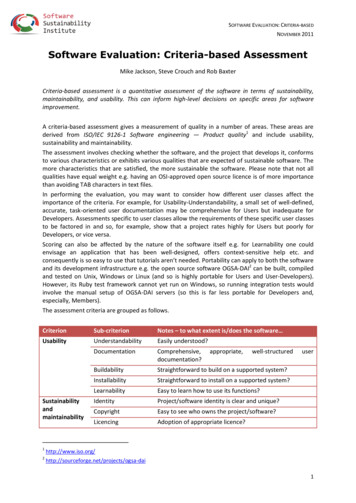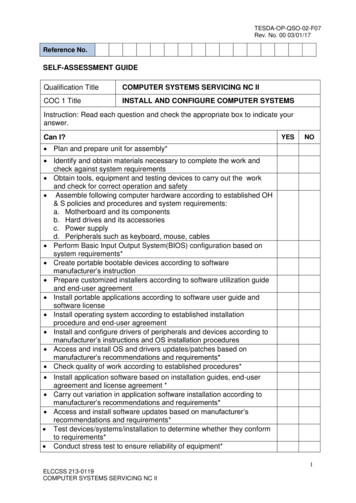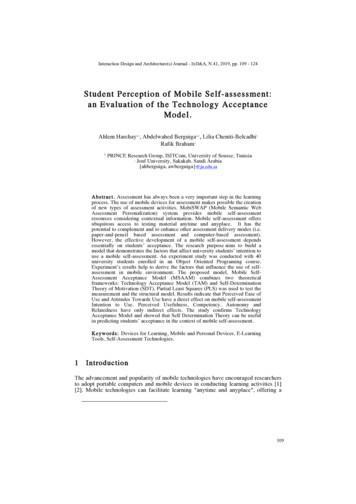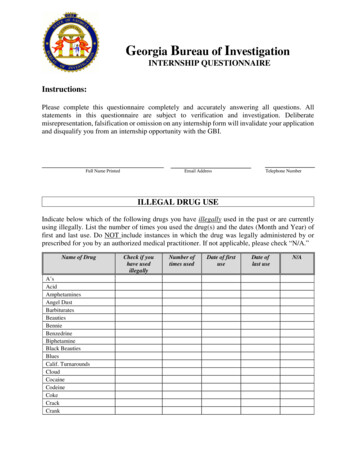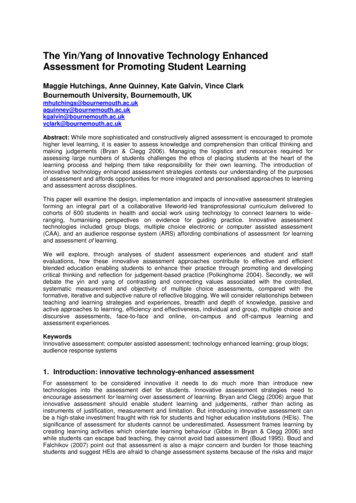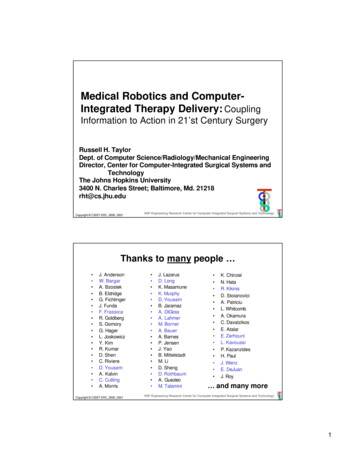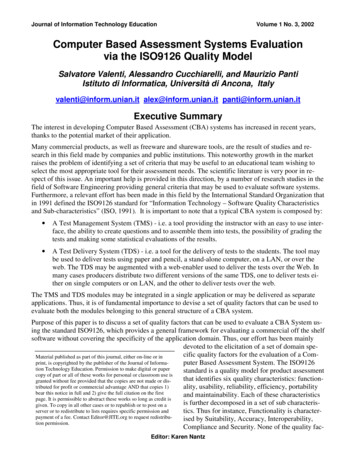
Transcription
Journal of Information Technology EducationVolume 1 No. 3, 2002Computer Based Assessment Systems Evaluationvia the ISO9126 Quality ModelSalvatore Valenti, Alessandro Cucchiarelli, and Maurizio PantiIstituto di Informatica, Università di Ancona, Italyvalenti@inform.unian.it alex@inform.unian.it panti@inform.unian.itExecutive SummaryThe interest in developing Computer Based Assessment (CBA) systems has increased in recent years,thanks to the potential market of their application.Many commercial products, as well as freeware and shareware tools, are the result of studies and research in this field made by companies and public institutions. This noteworthy growth in the marketraises the problem of identifying a set of criteria that may be useful to an educational team wishing toselect the most appropriate tool for their assessment needs. The scientific literature is very poor in respect of this issue. An important help is provided in this direction, by a number of research studies in thefield of Software Engineering providing general criteria that may be used to evaluate software systems.Furthermore, a relevant effort has been made in this field by the International Standard Organization thatin 1991 defined the ISO9126 standard for “Information Technology – Software Quality Characteristicsand Sub-characteristics” (ISO, 1991). It is important to note that a typical CBA system is composed by: A Test Management System (TMS) - i.e. a tool providing the instructor with an easy to use interface, the ability to create questions and to assemble them into tests, the possibility of grading thetests and making some statistical evaluations of the results. A Test Delivery System (TDS) - i.e. a tool for the delivery of tests to the students. The tool maybe used to deliver tests using paper and pencil, a stand-alone computer, on a LAN, or over theweb. The TDS may be augmented with a web-enabler used to deliver the tests over the Web. Inmany cases producers distribute two different versions of the same TDS, one to deliver tests either on single computers or on LAN, and the other to deliver tests over the web.The TMS and TDS modules may be integrated in a single application or may be delivered as separateapplications. Thus, it is of fundamental importance to devise a set of quality factors that can be used toevaluate both the modules belonging to this general structure of a CBA system.Purpose of this paper is to discuss a set of quality factors that can be used to evaluate a CBA System using the standard ISO9126, which provides a general framework for evaluating a commercial off the shelfsoftware without covering the specificity of the application domain. Thus, our effort has been mainlydevoted to the elicitation of a set of domain specific quality factors for the evaluation of a ComMaterial published as part of this journal, either on-line or inprint, is copyrighted by the publisher of the Journal of Informaputer Based Assessment System. The ISO9126tion Technology Education. Permission to make digital or paperstandard is a quality model for product assessmentcopy of part or all of these works for personal or classroom use isthat identifies six quality characteristics: functiongranted without fee provided that the copies are not made or distributed for profit or commercial advantage AND that copies 1)ality, usability, reliability, efficiency, portabilitybear this notice in full and 2) give the full citation on the firstand maintainability. Each of these characteristicspage. It is permissible to abstract these works so long as credit isis further decomposed in a set of sub characterisgiven. To copy in all other cases or to republish or to post on aserver or to redistribute to lists requires specific permission andtics. Thus for instance, Functionality is characterpayment of a fee. Contact Editor@JITE.org to request redistribuised by Suitability, Accuracy, Interoperability,tion permission.Compliance and Security. None of the quality facEditor: Karen Nantz
Computer Based Assessment Systems Evaluationtors discussed above can be measured directly, but must be defined in terms of objective features to beassessed. These features should be identified by taking into account the context of the evaluation, i.e., adescription of the target system, and the environment into which it will be deployed. The quality characteristics defined by the ISO 9126 standard may be classified with respect to the domain “specificity” coordinate. Functionality, for instance, is highly dependent on the educational domain to which CBA systems belong. On the other hand, Maintainability is a feature that can be only evaluated either by the developer or by a third party having at his disposal the technical documentation of the project and thesource code. A third class is represented by the quality characteristics that, although assessable, are independent from specific domain taken into account, as for instance, portability.In this paper we will focus the discussion on the domain specific aspects of the ISO9126 standard, i.e.Functionality, Usability and Reliability, leaving untreated the remaining characteristics that are eitherdomain independent or un-assessable by the end users. For each domain specific quality factor, we willdiscuss the common features of the Test Management and of the Test Delivery sub-systems, and thentake into account those applicable to each one of the two functional components in special sub-sections.Thus, the discussion is organised as shown in table A.Characteristic lity of TMSsSuitabilitySuitability of erability & Understandability of TMSsUnderstandabilityOperability & Understandability of TDSLearnabilityReliabilityTable A – Characteristics that will be discussed in the paperThe term cheating is used to address dishonest practices that students may pursue in order to gain bettergrades. In the final section of the paper, we will discuss cheating control from the technical point ofview, presenting some requirements that should be satisfied either at the component or at the systemlevel of a TDS. We will also discuss how an attempt at controlling cheating may affect the interface, thequestion management and the test management functional blocks of a TDS. Then we will discuss theeffects of cheating control on the security of a TDS.As a follow-up of this work the list of quality factors identified in the paper will be hosted as a questionnaire on the web site of our department and made available to all researchers wishing to review a CBAsystem.The obtained results will be made available to all interested parties.Keywords: Evaluation, Computer Based Assessment Systems, ISO9126, Quality model158
Valenti, Cucchiarelli, & PantiIntroductionMost solutions to the problem of delivering course content, supporting both student learning and assessment, nowadays imply the use of computers, thanks to the continuous advances of InformationTechnology. According to Bull (1999), using computers to perform assessment is more contentious thanusing them to deliver content and to support student learning. In many papers, the terms Computer Assisted Assessment (CAA) and Computer Based Assessment (CBA) are often used interchangeably andsomewhat inconsistently. The former refers to the use of computers in assessment. The term encompasses the uses of computers to deliver, mark and analyze assignments or examinations. It also includesthe collation and analysis of data gathered from optical mark readers. The latter (that will be used in thispaper) addresses the use of computers for the entire process, including assessment delivery and feedbackprovision (Charman and Elmes, 1998).The interest in developing CBA tools has increased in recent years, thanks to the potential market oftheir application. Many commercial products, as well as freeware and shareware tools, are the result ofstudies and research in this field made by companies and public institutions. For an updated survey ofcourse and test delivery/management systems for distance learning see Looms (2001). This site maintains a description of more then one hundred products, and is constantly updated with new items. Thisnoteworthy growth in the market raises the problem of identifying a set of criteria that may be useful toan educational team wishing to select the most appropriate tool for their assessment needs. According toour findings, only two papers have been devoted to such an important topic (Freemont & Jones, 1994;Gibson et al., 1995). The major drawbacks shown by both papers are: a) the unstated underlying axiomthat a CBA system is a sort of monolith to be evaluated as a single entity, and b) the lack of an adequatedescription of how the discussed criteria were arrived at. Since anyone could come up with some kind oflist, what needs to be known is what makes them valid.A typical CBA system is composed by: A Test Management System (TMS) - i.e. a tool providing the instructor with an easy to use interface, the ability to create questions and to assemble them into tests, the possibility of grading thetests and making some statistical evaluations of the results. A Test Delivery System (TDS) - i.e. a tool for the delivery of tests to the students. The tool maybe used to deliver tests using paper and pencil, a stand-alone computer, on a LAN, or over theweb. The TDS may be augmented with a web-enabler used to deliver the tests over the Web. Inmany cases producers distribute two different versions of the same TDS, one to deliver tests either on single computers or on LAN, and the other to deliver tests over the web. This is the policy adopted for instance by Cogent Computing Co. (2000) with CQuest-Test and CQuest-Web.The TMS and TDS modules may be integrated in a single application, as for instance InQsit (2000) developed by the Ball State University, or may be delivered as separate applications. As an instance of thislatter policy, we may cite ExaMaker & Examine developed by HitReturn (2000).Therefore, it is very important to identify a set of quality factors that can be used to evaluate both themodules belonging to this general structure of a CBA system.Although the literature on guidelines to support the selection of CBA systems seems to be very poor,there are many research studies in Software Engineering providing general criteria that may be used toevaluate software systems (Anderson, 1989; Ares Casal et al., 1998; Henderson et al., 1995; Nikoukaranet al, 1999; Vlahavas et al. 1999). A relevant effort has been made in this field by the International Standard Organization which in 1991, defined the ISO9126 standard for “Information Technology – Software Quality Characteristics and Sub-characteristics” (ISO, 1991).159
Computer Based Assessment Systems EvaluationThis paper identifies a set of quality factors that can be used to evaluate a CBA System using the standard ISO9126, which provides a general framework for evaluating a commercial off the shelf softwarewithout covering the specificity of the application domain. Thus, our effort has been mainly devoted tothe elicitation of a set of domain specific quality factors for the evaluation of a Computer Based Assessment System.ISO9126 Quality ModelThe standard ISO9126 is a quality model for product assessment that identifies six quality characteristics: functionality, usability, reliability, efficiency, portability and maintainability.Functionality is “a set of attributes that bear on the existence of a set of functions and their specifiedproperties” (ISO, 1991). The functions are those that satisfy stated or implied needs. This characteristicanswers the question: Are the required functions available in the software to be assessed?Usability is “a set of attributes that bear on the effort needed for use, and on the individual assessment ofsuch use by a stated or implied set of users” (ISO, 1991). The degree of usability will depend on who theusers are. The problem with usability is that it depends on people’s perceptions of what is easy to use.Therefore, usability is the least objective quality factor and the most difficult to measure.Reliability is “a set of attributes that bear on the capability of software to maintain its level of performance under stated conditions for a stated period of time” (ISO, 1991). This characteristic answers thequestion: is the software under evaluation reliable?Efficiency is “a set of attributes that bear on the relationship between the level of performance of thesoftware and the amount of resources used, under stated conditions” (ISO, 1991).Portability is “a set of attributes that bear on the ability of software to be transferred from one environment to another” (ISO, 1991).Maintainability is “a set of attributes that bear on the effort needed to make specified modifications”(ISO, 1991). Maintenance requires analyzing the software to find the fault, making a change, ensuringthat the change does not have side effects and then testing the new version.Each of the quality characteristics is decomposed in subcharacteristics, as shown in Table 1.None of the quality factors discussed above can be measured directly, but must be defined in terms ofobjective features to be assessed. These features should be identified by taking into account the contextof the evaluation, i.e., a description of the target system, and the environment into which it will be deployed. To buy a car, the context is the customer situation, i.e. financial resources, driving patterns, aesthetic tastes, and so on. For an organization, the context includes the organization's mission, its structure,and its existing procedures for the tasks that will be affected by the target system. From the context, theproject personnel will adduce various, possibly ill defined, qualities that the target system should exhibit(Hansen, 1999).The quality characteristics defined in the ISO 9126 standard may be classified with respect to the domain “specificity” coordinate. Functionality, for instance, is highly dependent on the educational domainto which CBA systems belong. On the other hand, maintainability is a feature that can be only evaluatedeither by the developer or by a third party having at his disposal the technical documentation of the project and the source code. In our opinion it is impossible for the end-user to assess the maintainability ofan off-the-shelf package. A third class is represented by the quality characteristics that, although assessable, are independent from specific domain taken into account. Portability, for instance, belongs to thiscategory. Pilj (1996) suggests adopting the checklist of table 2 to evaluate Installability, a sub-item ofPortability.The checklist of Table 2 is general enough to be used to evaluate any kind of software.160
Valenti, Cucchiarelli, & PantiTable 1 – The ISO9126 Characteristics and SubcharacteristicsQuality Factors for the Evaluation of a CBA SystemIn this section we will focus our discussion on the domain specific aspects of the ISO9126 standardFunctionality, Usability and Reliability, leaving untreated the remaining characteristics that are eitherdomain independent or un-assessable by the end users. The interested reader can find a discussion and a161
Computer Based Assessment Systems EvaluationTable 2 - A checklist for the evaluation of Installability (adapted fromPilj, 1996)number of checklists that support the evaluation phase of the remaining quality factors in the IEEE Recommended Practice for Software Acquisition Standard (IEEE, 1993): a standard describing “a set ofuseful quality practices that can be selected and applied during one or more steps in a software acquisition process”.For each domain specific quality factor, we will discuss the common features of the Test Managementand of the Test Delivery sub-systems, and then take into account those applicable to each one of the twofunctional components in special sub-sections.Table 3 provides a synoptical view of the quality factors and of their sub-characteristics that will be discussed in this section.FunctionalityThe subcharacteristics for functionality include suitability, security and interoperability.SuitabilityIn our view suitability represents the most important quality factor to be taken into account when evaluating a CBA system.Suitability of TMSThe Test Management System should provide the instructor with an easy to use interface, the ability tocreate questions and to assemble them into tests, and the possibility of grading the tests and makingsome statistical evaluations of the results. Therefore, as an indirect measure of suitability we decided toadopt the question management and test management capabilities. Question management is related to allaspects of the authoring questions; test management concerns the assembling of questions into examsand the evaluation of the results.Question Management. “Types of questions” and the “Question structure” can be used to assess thequestion management issue.Types of Questions. The most common types of questions are multiple choice, multiple response,true/false, selection/association, short answer, visual identification/hot spot and essay (Cucchiarelli,2000). Each of the question categories may be used to evaluate different types of knowledge. Therefore,the selection of a TMS may be driven by the ability to be assessed, according to the class of questionsmade available. On the other hand, many universities are adopting the same tool for all courses in orderto reduce costs and to allow students to interact in the same way throughout their evaluation process.This obviously imposes the requirement of selecting a TMS that provides the widest range of questiontypes available since different learning outcomes may be assessed within different courses.162
Valenti, Cucchiarelli, & PantiWhile almost all commercial TMS provide the abilityto build multiple choice questions (MCQ), very fewof them implement Hot Spot or Selection/Associationtype questions. An even smaller subset of TMS claimto implement Essay type questions (CQuest, 2000;InQsit, 2000). Although there are some research efforts on the automatic scoring of essay type questions,mainly in the area of natural language understanding(Burstein & Chodorow, 1999; Foltz et al.,1999), theassessment of this class of questions relies on themanual intervention of the teacher for the commercialproducts on the market.Question Structure. We can distinguish among information specific to the question type, informationtied to the educational task to be assessed through thequestion and information related to the scoring policyadopted (thus dependent on the question type). Not allthis type of information is made available by existingTMS: therefore this is an interesting aspect for identifying the system that best matches the educationalneeds to be assessed.Table 3 – Domain specific quality factorsand subcharacteristics for CBA SystemsAs an example of information available on questiontype, we will discuss multiple choice questions. Thisclass of questions is organized into three parts: astem, a key and some distractors. The problem towhich the student should give an answer is known asstem. The list of suggested solutions may includewords, numbers, symbols or phrases and are calledalternatives, choices or options. The student is askedto read the stem and to select the alternative that isbelieved to be correct. The correct alternative whichmust be one, and only one, is simply called the key,whilst the remaining choices are called distractors,since their intended function is to distract studentsfrom the correct one.To evaluate the question structure of a TMS, the number of different choices allowed and the appearance they have (radio vs. push buttons) must be taken in account. It is useful to note that the spreadamong the maximum number of allowed distractors for different TMS is very large, ranging from 3 to“no reasonable limit” for Perception (Perception, 2001). This could be used as a metric for the evaluation of a TMS, although many authors suggest that four choice items are good enough to reduce thechance of guessing the result while maintaining the effort of devising a real equivalent number of distractors (usually the fourth distractor in five choice questions tend to be difficult to devise and is weakerthan the others). (Gronlund, 1985, p. 183)The educational task to be assessed represents another important issue. In fact, if the test is used toevaluate the instructional process, additional fields to store a) the source of each question, b) the paper towhich it is related and c) the topic covered and d) the author of the question itself ought to be provided.Furthermore, a teacher may wish to assess a topic at different cognitive levels, such as those defined in163
Computer Based Assessment Systems Evaluationthe well known Bloom’s taxonomy (Bloom, 1956). Thus, an additional field for storing such information should be defined.Many commercial TMS allow user-defined fields. Therefore, a good selecting criterion would be theability to access these fields to perform test evaluation procedures.Each class of available questions may support different scoring schemes. The simplest way to assign ascore to a MCQ is to mark 1 for the correct answer and 0 for the other options. This strategy allows students who make blind guesses or give random responses to all questions to obtain a score that may beevaluated as the number of questions divided by the number of distractors used: this means that a luckystudent who is submitted to a test with 100 MCQ with 4 distractors may obtain a score of up to 25. Another approach called negative marking, assigns 1 for the correct response, 0 for no response and -1/(n1) for an incorrect response. With this approach, a student who knows nothing, and therefore makescompletely blind guesses may be marked with the plausible score of "about" zero. Obviously, a TMSshould allow both of these marking schemes. For short answer questions the scoring scheme could either take into account or ignore letter case. Furthermore, it could prove useful to find a phrase inside ananswer rather than considering the whole answer. The TMS should allow both features. For hotspotquestions it should be possible to associate different scores to different areas of the image containing theinformation to be identified.A question should provide feedback containing the mark to the given response along with commentsreflecting the user’s performance. The feedback could be presented either after any single question (thissolution being preferable for self-evaluation tests) or at the end of the test and may be based on the overall performance.Last, but not least, the inclusion of multimedia, such as sound and video clips or animated images, mayimprove the level of comprehension of a question.Test Management. Among the issues that qualify a TMS with respect to Test Management, we suggesttaking into account: the way in which exams can be prepared (test preparation); the availability of features for importing test banks that may be used to simplify the task of testpreparation (test banks); the tools available to the teacher to evaluate the test (test evaluation tools); the tools available to the teacher to analyze the responses produced by the students (responseanalysis).Test preparation. Once questions have been defined, they should be selected and organized into tests.Test preparation is a non-trivial task, since it requires the ability both to manually choose the questionsfrom the database and to construct the exam through a random selection approach. This implies thatquestions could be selected with respect to different objectives as for educational goals, keywords, contents, statistical value and so on.Furthermore, to build adaptive tests represents an important “add-on” for the selection of the TMS.Adaptive testing is used to allow the student to move forward or backwards in a test depending on his orher performance. This is a very powerful feature, since it allows the creation of material reacting "intelligently" to what the student does. Very few commercial TMS provide adaptive testing features (FastTest Pro, 2001; Perception, 2001) and usually the construction of adaptive tests is not very simple fromthe instructor’s point of view since it requires the use of a sort of programming language to cope withthe possible actions to be enacted according to the student’s responses.164
Valenti, Cucchiarelli, & PantiMoreover, it should be possible to create multiple forms by rearranging questions, either by some instructor intervention or automatically, in order to discourage cheating. Tools that provide the ability torandomize the order of answers for a question may further discourage cheating.Finally, some countermeasures should be provided to prevent testing from turning into a guessing activity. This result could be obtained by introducing penalties for guessing, and or by adopting “restriction”functions to specify that no other testing attempt could be made within a given time span. This way thestudent may be allowed to reflect on his/hers mistakes.Test banks. Questions can be assembled in a bank that is further referenced by the test. Test banks arevery useful in a number of ways, since organizing questions related to the same topic in a bank maysimplify both the random selection of questions and the evaluation of the understanding of the topicthrough statistical measures. Moreover, the same bank can be shared by different tests. This last pointsuggests that it is possible to reuse the same material, saving time and effort. Obviously, different instructors may share the same questions thus obtaining synergies and homogenizing the way in which thesame topic is assessed in different courses. Building well-formed questions is an arduous task. The possibility of accessing question banks provided by well-known scientists or by professional organizationsis significant for the educational community. As an example, we can cite the effort made by a numberof Student Chapters of the Association for Computing Machinery that are collecting test banks related tocomputer science (ACM-SC, 2001).Therefore, a TMS should provide the possibility to create multiple banks with an unlimited number ofitems in each bank, and the ability to import questions and corresponding data from existing banks.Test evaluation tools. Tests should be evaluated both before and after administration (Gronlund, 1985).Evaluating a test before administration means analyzing it in terms of adequacy of test plan, text items,and text format and directions. From the point of view of test plan, analyzing a test means finding ananswer to the following questions: does the test plan adequately describe the instructional objectives, and the contents to be measured? does the test plan clearly indicate the relative emphasis to be given to each objective and eachcontent area?Each test item needs to be evaluated in terms of appropriateness, relevance, conciseness, ideal difficulty,correctness, technical soundness, cultural fairness, independence and sample adequacy.Finally, for the test format and directions, analyzing a test means, for example, finding an answer to thefollowing questions: Are the test items of the same type grouped together in the test or within sections of the test? Are the correct answers distributed in such a way that there is no detectable pattern? Is the test material well-spaced, legible, and free of typographical errors?Evaluating a test after administration helps a) to verify whether it worked as intended in order to adequately discriminate between low and high achievers and b) to discover whether the test items were ofappropriate difficulty and free of irrelevant clues or other defects (for instance, all distractors behavedeffectively in MCQ).Response analysis. Once questions have been devised and the test delivered, it is of fundamental importance to obtain an assessment of the students individually and with respect to the class. We have alreadydiscussed the importance of providing the instructor with some tools for the assessment of the evaluation165
Computer Based Assessment Systems Evaluationprocess. To attain such results, the TMS should provide the instructor with at least the following information: test performance report for each individual examinee, with the percentage of correct answers andrelative ranks; individual response summary by item, with an error report that lists wrong vs. correct responses; class test performance with distribution, means and deviations; item statistics and analysis with indicators that may be useful to evaluate the questions in termsof reliability, discrimination and difficulty.Although the system may provide some numerical results to measure the test, the responsibility ofevaluating them and to identify strategies and policies to modify the educational process in order to improve the understanding of mis-concepted topics is left to the instructor.Most TMS provide built-in facilities for the analysis of responses. More sophisticate analyses can becarried out via optional external modules. As an example, Assessment System Co. delivers a large set ofdifferent programs both for item and test analysis. “These programs are based on classical test theory, onRasch model analysis using the 1- 2- and 3-parameter logistic Item Response Theory (IRT) model, onnonparametric IRT analysis, and on IRT analysis for attitude and preference data” (Assessment SystemCo, 2001).Suitability of Test Delivery SystemA TDS is a tool for the delivery of tests to the students. We decided to adopt the Question and test management capabilities to evaluate the Suitability. Question management relates to all aspects concerningquestions handling while test management relates to test delivery.To evaluate the
via the ISO9126 Quality Model Salvatore Valenti, Alessandro Cucchiarelli, and Maurizio Panti Istituto di Informatica, Università di Ancona, Italy valenti@inform.unian.it alex@inform.unian.it panti@inform.unian.it Executive Summary The interest in developing Computer Based Assessment (CBA) systems has increased in recent years,

